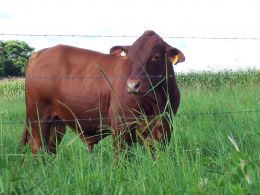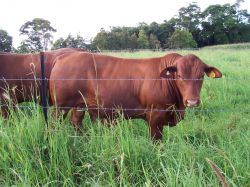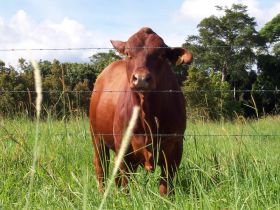Senepol Composite Bulls
The biggest gain to be made in the Australian beef industry is increasing fertility rates across predominantly Bos indicus herds in Northern Australia. A lack of fertility in Northern Australia , can be attributed to two variables:- genetics and nutrition.
The secret to maximising pregnancy rates in Northern Australia under the genetics banner, is in using adapted Bos Taurus breeds in the crossbreeding mix. Temperate Bos Taurus breeds (Angus, Charolais, Shorthorn etc.) are very fertile in their own environments, such as Britain, Europe or Southern Australia.
However, in Northern Australia's hot, dry and seasonally wet tropical climate, parasite loads, low nutrition and long distances, can override the productive traits of these British and European breeds, so much so, their own survival can be in jeopardy.
The Bos Indicus breeds [Brahman, Zebu, Sahiwal etc.) are renowned for their survival traits in harsh northern environments. However high fertility rates, are not necessarily evident in these Bos indicus breeds. In the CRC 2 program, it was found that 42 % of Bos indicus cows were not cycling whilst having a calf on them, as opposed to only 8% of the adapted Bos Taurus composites.
Adapted Bos taurus breeds, which include Senepol, Belmont Red and Bonsmara are generally African derived. That is they are Bos taurus breeds that have adapted to tropical climates in Africa for thousands of years. These breeds have then been crossed or blended with other Bos taurus breeds, and selected in tropical environments. Australian Agricultural Company (AACo), started using Senepol composite cattle in the late 1990's and saw an increase in pregnancy rates, when compared to the traditional indicus and indicus-derived herds. The list of research and trials indicating the increased fertility using a mix of these breeds, is compelling.
Pinnacle Pocket use only purebred, registered Senepol Bulls over a selection of high-fertility Droughtmaster females to produce specific herd bull genetics for clients.
Industry weight gain research of Senepol cross over Brahman
An extensive cross breeding trial in the NT identified a potential $100/head live export market advantage for F1 Brahman/Senepol steers over straight Brahman steers - & that was in 2015 dollars. NT DPI&F launched a trial by joining a common herd of Brahman females to Brahman bulls & Senepol bulls sourced from QLD. Senepols were selected largely because of their polledness, tick resistance & meat quality traits. F1 Senepol x Brahman steer & heifer progeny & straight Brahman progeny were run in the same paddocks under the same feed & management conditions to ensure a fair comparison. The 6-year trial compared the performance of both progeny groups in paddock conditions, in feedlots in Australia & Indonesia & has assessed the meat quality & final market value of both groups.
The Katherine research station, has been comparing Senepol cross Brahman, versus straight Brahman, in their breeding herds. The Senepol Brahman crosses, were over 10% heavier at weaning (23 kg), 10% heavier at 18 months (33kg) and had 10% more pregnancies for 2yr matings, and had achieved 97% poll or scurred progeny in one generation. At Victoria River Research station, they were on average over three years, 23 kg heavier, and at Manbulloo the F1 Senepol crosses were an average of 19 kg heavier. The 2012 weaners from Victoria River, 176 Sen/ Brah weaners weighed 230 kg, and 193 Brahman weaners weighed 200kg, showing a difference of 15%.
Post Weaning Performance of Heifers
The senepol F1 heifers that were bred on Victoria River were on average 22.1 kg heavier at weaning and then grew another 5.1 kg more than their Brahman counterparts over the following dry season. Following the cattle through the wet season, the F1 Senepol cattle grew another 15 kg heavier than their Bos Indicus contemporary group. As a result, the F1 Senepol X heifers were 45 kg heavier at 18 to 20 months, 86 Brahman heifers weighed 281 kg, and 41 senepol cross females weighed 326 kg (>16%).
Pregnancy rates of 2-year heifers
The heifers were mated as two years olds, and the Senepol F1 achieved a 94% preg rate versus an 84% rate with the straight Bos Indicus.
Poll or Scurred
The majority of senepol F1 Brahman progeny, were polled or scurred. The original Brahman cows, were predominantly a Horned herd and the resulting senepol progeny, recorded 97% poll or scurred, with 70% poll and 27% having some form of scurs in the females, in 53% and 43% respectively in the males, from 392 head.
By 2015, Pre & post-weaning growth
- All weaned male calves from both genotypes were cell grazed for growth studies as one mob on improved buffel pasture & females were placed on native pastures.
- The F1 Senepol weaners were on average 21kg heavier at weaning than the Brahmans
- Growth - from 6 to 18 months: After four years of trials F1 Senepol steers put on 12.3kg on average more between June & March
- At 18 months the F1 Senepol steers were on average about 33kg heavier
- Market value: On current export prices to Indonesia then $2.70/kg the extra 33kg equates to an additional $89/head.
- Fat cover: The Senepol cross steers tended to be slightly leaner at the same weight.
- The F1 Senepol x Brahman weaning weights were 26kg heavier than the Brahmans, while maiden joining weights as 2 yr. old were 35kg heavier.
A comparison of the growth & meat tenderness
- March 2013 all steers from both genotypes that were approaching the 350kg cut off weight for export to Indonesia were sold. F1 Senepol steers were 38kg heavier at time The heavier weights at that age meant 54% of the F1 steers had achieved live export weights by March 2013 compared to 16% of the Brahman steers.
- July 2013 25 steers of each genotype trucked to SE QLD (3300km, 5-days). Weight loss was 12pc.
- F1s recording an Average Daily Gain (ADG) of 1.84kg & Brahmans 1.82kg.
- After 73 days on feed the steers were slaughtered. The F1 Senepols graded two MSA boning groups lower than Brahmans. The F1s averaged 6.3 & Brahmans 8.3 (Boning groups of 9 or lower attract MSA premiums). Average hump height of the Brahman steers was 138mm compared to F1 Senepols with 88mm.
- The F1 Senepol meat was significantly more tender, with 0.44 kg less shear force required to cut the meat compared to the Brahmans (3.43 kg for F1s compared to 3.86 kg for Brahmans).
- Advantages of F1 Senepols were that they graded better for MSA mostly due to lower hump height & had significantly more tender meat, & effectively offered producers ‘more margin for error’ in the event of a poorer season or shorter time in the feedlot.
Indonesian feedlot comparison
Mr Schatz said that despite the production & meat quality advantages offered by cross breeding with tropically adapted Bos Taurus cattle, some northern cattle producers were reluctant to embrace crossbreeding due to a perception that Indonesian lot feeders preferred high grade Brahman.
- Steers at suitable export weight for Indonesia were selected in Feb 2014, with 57% of F1 steers achieving that weight & 24% of Brahmans. The average induction weight of the F1 steers was 312kg & Brahmans 308kg.
- Steers were managed together under normal feedlot management for 121 days on Indonesian feedlot ration of tapioca waste, copra meal, palm kernel meal, distiller’s grain, Napier grass & molasses. The steers were then slaughtered at the Bogor abattoir & boned out for the restaurant market.
- Over the 121 days on feed the F1 Senepols produced a higher ADG of 1.71kg per day, compared to Brahmans with 1.54kg, with the F1s putting on 21.6kg more weight during the time on feed than the Brahmans.
- The final average P8 fat depth was about the same in both genotypes even though the F1 Senepols were close to 25kg heavier - a positive for Indonesian lot feeders because it means cattle can be fed to heavier weights without becoming over fat.
- The average boning room yield was 2.4pc higher for the F1s
Mr Schatz said the Indonesian feedlot operators were very happy with the crossbred cattle, with the additional meat tenderness giving them the additional option of being able to feed them for a longer period to target the restaurant market. “In summary we found that F1 Senepols offered production advantages to Indonesian feedlotters as well as Australian cattle producers” he said.
Breeding fertile, tropically adapted, well muscled cattle that produce tender beef




